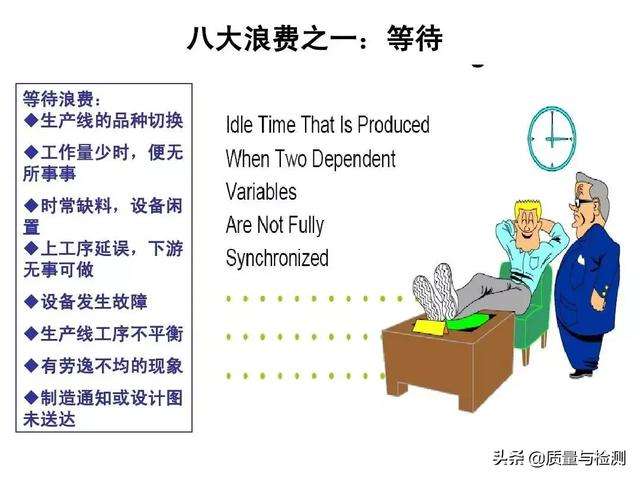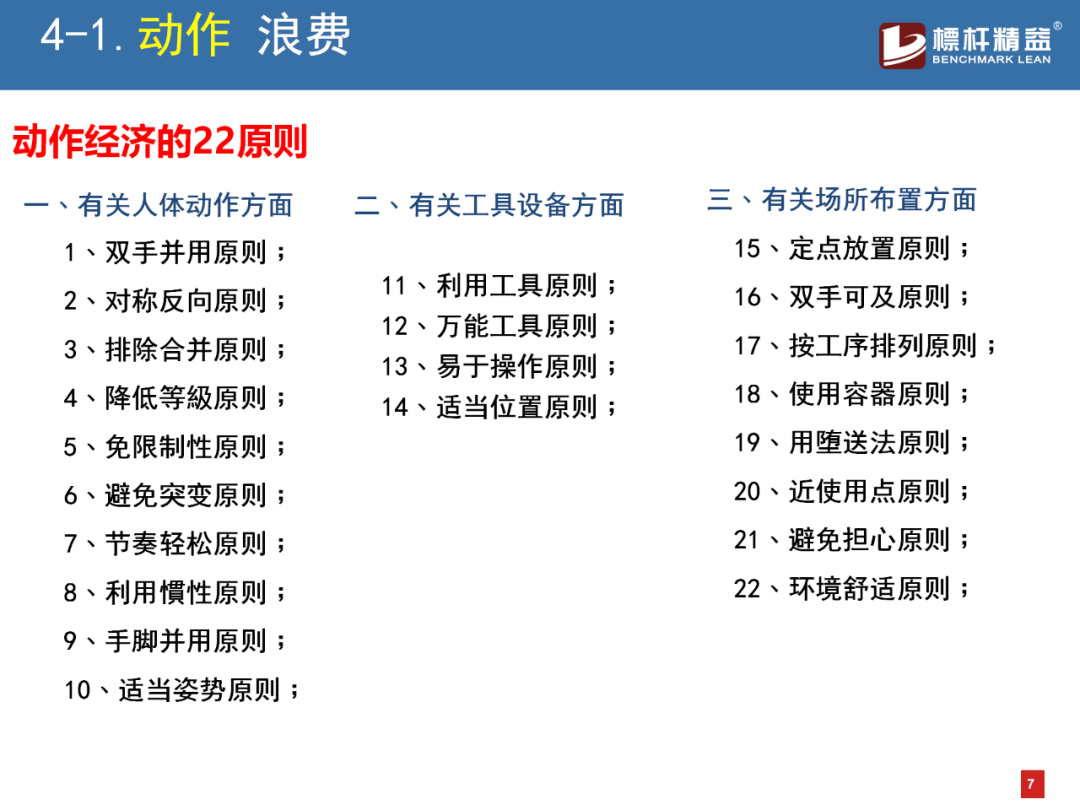7 Waiting8 big wastesWaste of unnecessary waiting time during the production process8 big wastes, such as equipment failure, material shortage or unreasonable production planning, causing employees to wait or equipment to be idle, for example8 big wastes8 Waste of resources caused by improper management or inefficient management, such as management mistakes in decision-making, cumbersome management processes or poor management information. For example, cumbersome management processes lead to increased employee communication and coordination time. By reducing these eight waste phenomena, companies can improve production efficiency, reduce production costs and enhance market competition.
11 Waste of movements, such as foot movements, object movements, hand movements, eye movements, body movements, etc. 3 Waste forms 1 barely exceed the ability limit 12 Insufficient ability and defective products need to be repaired 4 Waste forms 2 Excess 21 Ability, but not fully utilized 5 Waste forms 2 Excess 22 Ability, too much processing or production 6 Waste forms 3 No.
Eight major wastes: 1 The waste of poor repairs; 2 the waste of excessive processing; 3 the waste of action; 4 the waste of transportation; 5 the waste of inventory; 6 the waste of excessive manufacturing; 7 the waste of waiting; 8 the waste of management; 1 The error prevention method FoolProof ensures that the work can be done correctly the first time; 2 The economic principle of action improves the human body's movements, reduces fatigue, and makes work easier.
5 Waste of inventory refers to waste such as capital occupation and damage to goods caused by excessive inventory. 6 Waste of excessive manufacturing refers to waste of resources caused by advance or excessive production. 7 Waste of waiting refers to waste caused by employees or equipment during the waiting process. 8 Waste of management refers to waste of resources caused by poor management, such as poor decision-making and poor communication. In order to reduce these wastes, it is recommended that companies strengthen quality management and reduce defects.
The eight major wastes are the waste of defective repairs, the waste of excessive processing, the waste of operation, the waste of transportation, the waste of inventory, the waste of manufacturing too much too early, the waste of waiting and the waste of management. Purpose of Use 1: Prevention of errors FoolProof How to avoid doing wrong things, so that the spirit of doing work well the first time can be concretely realized 2: Action improvement method Action economic principles Action change method Improve the human body.
1. Bad and repair waste Products need to be reworked and repaired because they do not meet quality standards, resulting in extra time and costs. 2. Excessive processing waste. Production contains unnecessary processing steps or over-design, thereby increasing production time and resource consumption. Three actions waste unnecessary actions of employees in the production process, such as unnecessary walking or tool hunting, which reduces work efficiency. 4. Handling wastes unreasonable materials.
The eight major wastes include 1 defects and trimming waste, including material time for additional repair and inspection losses, 2 excessive processing wastes unnecessary high-precision processing and additional operating time and resources, 3 actions waste unnecessary actions, such as excessive hand idle movements, etc. 4 Handling waste of products that do not produce value, resulting in waste of space, time and manpower. 5 Inventory waste excessive inventory hides problems and increases.
Under the JIT production method, the eight major wastes in the factory are waste of defects and repairs, waste of excessive processing, waste of transportation, waste of inventory, excessive manufacturing, waste of premature waiting, and waste of management and waste of repairs refer to defective products and maintenance costs generated during the production process. These defective products not only increase production costs, but also may lead to reduced customer satisfaction. Excessive processing.
The eight major wastes are overproduction, inventory, substandard products, action waste, waiting waste, handling waste, processing waste and overmanufacturing--Overproduction overproduction refers to the manufacture or production of items or products that exceed actual demand. This waste not only involves the excessive use of resources such as raw materials, equipment and space, but may also lead to unnecessary cost increases, such as warehousing expenses and management expenses. 2. Excessive inventory means that funds are lost.
The eight major wastes refer to the waste of defective repairs, waste of excessive processing, waste of actions, waste of handling, waste of inventory, waste of manufacturing too early, waste of waiting, and waste of management and waste of defective repairs. This waste refers to the additional costs and time incurred in repairing defective products after producing defective products. In the JIT production method, any defective products are not accepted because they will increase production costs.
5 Action waste includes the sudden stop of idle work with both hands and one hand. These unnecessary actions waste resources and time. 6 Inventory waste. Unnecessary inventory hides many problems and may lead to resource waste. 7 Handling waste includes actions such as placing, stacking and moving the entire column, which wastes space, time and manpower. 8 Creating too much waste consumes production resources in advance, and has no practical benefits.
Too much manufacturing is premature waste or excessive production leads to excess products, the inability to sell or store in a timely manner, and the time waiting for processing and waiting for materials or waiting for instructions on the production line is wasted, resulting in idle management of resources and inefficient management decisions or processes, resulting in resource waste and inefficiency By identifying and eliminating these eight wastes, factories can optimize production processes, improve production efficiency, and maximize resource utilization.
The two pillar value streams focus on the entire process of products or services from raw materials to customer delivery, aiming to identify and eliminate non-value-added activities among them. Pulled production is produced according to actual demand, avoiding excessive production and inventory backlog, and realizing the five principles of on-demand supply. Value emphasizes meeting customer needs and ensuring that the value of products or services is consistent with customer expectations. The value stream is the same as above, focusing on the entire process and eliminating wasteful flow pursuits.
5. Processing waste Processing waste, also known as waste of excessive processing, means that in machining operations, all unnecessary processing unrelated to project progress and processing accuracy is wasted. 6. Excessive inventory waste is mainly due to production planning control methods. There is no reasonable arrangement of production volume, and products are not produced and processed according to market demand. At that time, products with small audiences will continue to be produced, and a large number of products will be piled up in warehouses.
6 Processing waste, also known as excessive processing waste, refers to unnecessary processing carried out during machining. These processes have nothing to do with project progress and processing accuracy. 7 Inventory waste is caused by improper production control methods. Production is not driven by market demand, resulting in excessive product inventory, which not only occupies storage space, but also increases costs. 8 Management waste points out that at present, at the manufacturing site, management efficiency is low due to the lack of effective management personnel and systems.





还没有评论,来说两句吧...